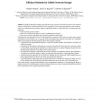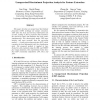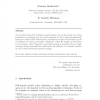92 search results - page 5 / 19 » Intuitive quasi-eigen faces |
ICALP
2009
Springer
13 years 11 months ago
2009
Springer
Intuitively, Braess's paradox states that destroying a part of a network may improve the common latency of selfish flows at Nash equilibrium. Such a paradox is a pervasive phe...
IVC
2006
13 years 7 months ago
2006
Thermal infrared (IR) imagery offers a promising alternative to visible imagery for face recognition due to its relative insensitive to variations in face appearance caused by ill...
SCA
2007
13 years 9 months ago
2007
In this paper, we present an intuitive interface for interactively posing 3D facial expressions. The user can create and edit facial expressions by drawing freeform strokes, or by...
ICPR
2006
IEEE
14 years 1 months ago
2006
IEEE
This paper develops an unsupervised discriminant projection (UDP) technique for feature extraction. UDP takes the local and non-local information into account, seeking to find a p...
RTA
2005
Springer
14 years 27 days ago
2005
Springer
A convenient method for defining a quasi-ordering, such as those used for proving termination of rewriting, is to choose the minimum of a set of quasi-orderings satisfying some d...



